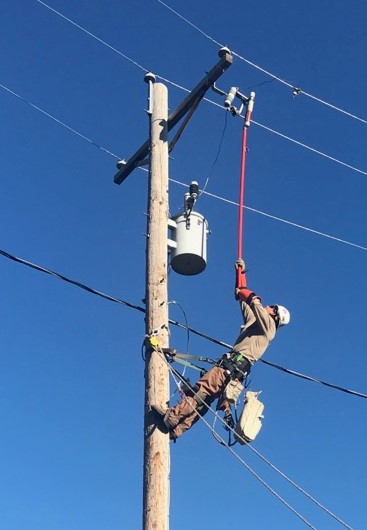
Its temperature has nothing to do with its name.
A “hot stick” is one of the most-used tools in a line technician’s toolbox. And is plays an important role in keeping them safe.
What is it?
A “hot stick” is a fiberglass rod that is long enough to keep linemen at a safe distance from energized equipment while they work. Being made of fiberglass allows the stick to not conduct electricity. And keeping a lineman 6-10 feet out from energized equipment also keeps them out of the dangerous arc zone. That area is where an arc flash can occur – which results from electricity connecting through air to ground or another voltage phase.
“A hot stick is kind of like a pair of pliers to a mechanic,” said Lee O’Neal, director of T&D Construction at OPPD. “It’s something they use all the time.”
Hot sticks range in size depending on the job, and can be used on padmount transformers and fuses high on a distribution pole. It all depends on the hardware on the end.
How does it work?
 When working inside a transformer, there are cables that terminate – or end – inside. Line technicians hook the end of the hot stick into the end of the cable to remove it from the connection and reconnect it into the port when repairs are complete.
When working inside a transformer, there are cables that terminate – or end – inside. Line technicians hook the end of the hot stick into the end of the cable to remove it from the connection and reconnect it into the port when repairs are complete.
On overhead power lines, fuses can sometimes open causing an outage. The lineman will use the hot stick from the ground to hook the end into the loop of the fuse and place it back into place.
About the hot stick
There are several kinds of hot sticks. Determining which one to use depends on the job at hand. Each stick has different hardware on the end to assist in the job. Some have a hook while others open with a lever low on the handle.

Because it is so vital to their work, line technicians take great care to keep hot sticks clean and dry. The slightest bit of dirt or grease can serve as an electrical conductor and put the lineman in the path of the current.
The hot sticks are also tested to ensure they meet standards, similar to the testing of rubber goods.

Laura King-Homan is the manager of Corporate Brand and Communication Operations, at Omaha Public Power District. She has nearly 20 years of print journalism and design experience, including the Omaha World-Herald.
View all posts by Laura King-Homan >







